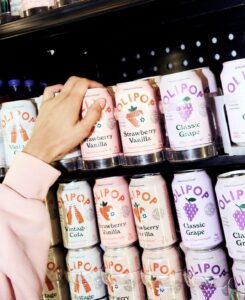Fizz Factor: How PR Strategies Drive Soda Brand Success
Published on Oct. 17, 2024 at 7:23 p.m.
By Jane Blissett.
Over the past 100 years, Coca-Cola and Pepsi have been the two major brands in the beverage industry. The two companies have fought neck and neck to become the people’s choice. With creative advertising, public relations stunts and marketing campaigns, Coca-Cola and Pepsi have pulled out all the stops to create an intensely loyal group of customers.
However, in today’s current landscape, other drink and soda brands are leveraging themselves with PR, causing brand loyalty to shake up.
Fragmentation and new PR strategies
The market has changed and grown, slowly splitting off into segments that cater to different consumer preferences and demands. The idea that there can be other concepts for beverages began to spiral, with energy drinks, sparkling water, kombucha and more hitting the shelves.
These brands also decided that they could change their strategies. Instead of huge time slot advertisements, they tapped into the trends going viral on social media and use PR more than marketing. They appealed to the younger audience by having a larger social media presence.
Brands pushing the envelope

New and trendy brands such as Poppi, Olipop, Spindrift and others have created relationships with influencers and capitalized on social media in powerful ways to captivate an audience.
In April 2024, Poppi partnered with social media star Alix Earle during Coachella to promote its new flavors and the entire brand itself, and sales and brand awareness increased by 200%.
The brand also supported Greek life across the country throughout sorority recruitment by sending products and inspiring rush themes. Poppi has focused on selling the brand rather than just the drink itself. Consumers want brands to connect with them, and that is exactly what Poppi is doing.
Additionally, Red Bull sponsors extreme sport athletes and holds competitions with its energy drinks and branding woven into the events.
Lauren Morris, a member of the sport media graduate program at Red Bull, said that having a niche in this industry is crucial.
“Red Bull has carved a niche for itself in the energy drink market by focusing on extreme sports and adrenaline-filled activities,” she explained. “The brand positioned itself as more than just a beverage but a lifestyle choice.”
Nowadays, a flavor can sell itself, but the aesthetic of the beverage needs to be a selling point for consumers.
What’s next for drink promotion
These drink companies are emphasizing their social responsibility and showing that they care about their target audiences. Many beverages now include ingredients such as probiotics that are gut healthy and incorporate health benefits. Consumers now are concerned with health trends, and brands are attempting to meet their standards. With changing trends comes the rise of innovative PR campaigns.

This shift in values has forced big name brands to update their PR strategies and to be more involved with their loyal audiences. Coca-Cola and Pepsi have focused on their sustainability efforts throughout their packaging and have promoted their environmental initiatives. They have been forced to adjust to their new competition.
With an ever-evolving industry, it is important to recognize the foundation and the beverages that started a compelling market. However, it is time to look at the trailblazers of the industry and how they are continuing to push the boundaries of a classic and original soda.




